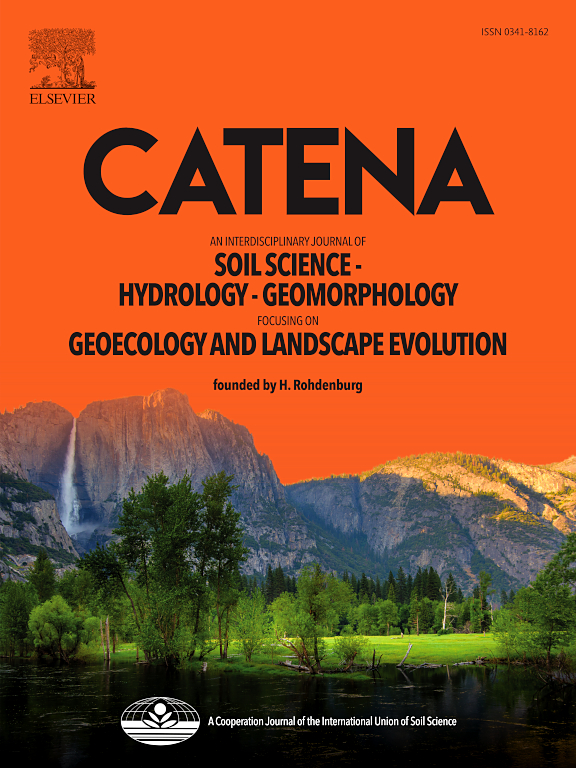Sediment apportionment in paired, small watersheds with runoff convergence from no-tillage forage and grain production in the subtropics
IF 5.4
1区 农林科学
Q1 GEOSCIENCES, MULTIDISCIPLINARY
引用次数: 0
Abstract
Areas with diversified livestock farming and intense agricultural use can lead to soil degradation, particularly in environmentally fragile regions. We collected samples of suspended sediments and potential sediment sources for five years (between 2016 and 2020), and determined geochemical tracer properties using inductively coupled plasma optical emission and X-ray fluorescence. We applied a combined sampling strategy based on land uses, being agricultural areas and unpaved roads, and erosion forms of drainage channels. In paired watersheds occupied with dairy and grain production, draining into one of the largest artificial lakes in southern Brazil. The geochemical tracers (Mn, Ti, and Fe) were chosen based on the conservativeness test, Kruskal-Wallis, and LDA correctly classified 77% of the sediment sources in both watersheds. The average RMSE and MAE for virtual mixtures were, respectively, 17% and 16% in the north watershed and 18% and 17% in the south watershed. The MixSIAR model showed unpaved roads contributed to most sediments (38% and 55%), followed by channel banks (37% and 30%) and crops (25% and 15% for the north and south watersheds, respectively). Unpaved roads are allocated perpendicular to the main contour lines, flow accumulation channels, surface flow direction, and landscape slopes. Thus, roads concentrate runoff and sediment from agricultural fields. The sediment apportionment reveals the need to focus on runoff control and road maintenance to reduce the risk of sedimentation and contamination of reservoirs, avoiding the loss of storage capacity for the supply of water and production of hydroelectric power.
畜牧业多样化和农业密集使用的地区会导致土壤退化,尤其是在环境脆弱的地区。我们收集了五年(2016 年至 2020 年)的悬浮沉积物和潜在沉积物源样本,并利用电感耦合等离子体光学发射和 X 射线荧光测定了地球化学示踪特性。我们根据土地用途(农业区和未铺设路面的道路)和排水渠道的侵蚀形式采用了综合采样策略。在奶制品和谷物生产的配对流域中,水流汇入巴西南部最大的人工湖之一。地球化学示踪剂(锰、钛和铁)的选择基于保守性测试 Kruskal-Wallis,LDA 正确分类了两个流域 77% 的沉积物来源。虚拟混合物的平均 RMSE 和 MAE 在北部流域分别为 17% 和 16%,在南部流域分别为 18% 和 17%。MixSIAR 模型显示,未铺设路面的道路造成的沉积物最多(分别为 38% 和 55%),其次是河道堤岸(分别为 37% 和 30%)和农作物(北部和南部流域分别为 25% 和 15%)。未铺设路面的道路垂直于主要等高线、水流汇集渠道、地表流向和地形坡度。因此,道路集中了来自农田的径流和沉积物。沉积物分布情况表明,有必要重视径流控制和道路维护,以降低沉积物沉积和污染水库的风险,避免损失水库供水和水力发电的储存能力。
本文章由计算机程序翻译,如有差异,请以英文原文为准。
求助全文
约1分钟内获得全文
求助全文
来源期刊

Catena
环境科学-地球科学综合
CiteScore
10.50
自引率
9.70%
发文量
816
审稿时长
54 days
期刊介绍:
Catena publishes papers describing original field and laboratory investigations and reviews on geoecology and landscape evolution with emphasis on interdisciplinary aspects of soil science, hydrology and geomorphology. It aims to disseminate new knowledge and foster better understanding of the physical environment, of evolutionary sequences that have resulted in past and current landscapes, and of the natural processes that are likely to determine the fate of our terrestrial environment.
Papers within any one of the above topics are welcome provided they are of sufficiently wide interest and relevance.
 求助内容:
求助内容: 应助结果提醒方式:
应助结果提醒方式:


